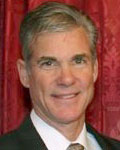Dear County and District Superintendents, Charter School Administrators, and School Food Service Directors:
IMPROVING STUDENT NUTRITION AND ACADEMIC ACHIEVEMENT
THROUGH SCHOOL BREAKFAST PROGRAMS
THROUGH SCHOOL BREAKFAST PROGRAMS

I am proud to be the honorary chair of the BreakfastFirst Campaign. Promoting the School Breakfast Program (SBP) is integral to my Team California for Healthy Kids campaign, which focuses on making healthy choices the easy choices.
In alignment with the Team California for Healthy Kids goal to promote good eating habits, BreakfastFirst aims to ensure that all students are served an optimally nutritious breakfast using innovative models such as Classroom Breakfast, Grab-and-Go, and Second Chance Breakfast. These modes of service are known to dramatically increase participation, bringing the benefits of school breakfast to the maximum number of students.
Research confirms the clear connection amongst health, learning, and attendance. Healthy children are more successful in school, miss fewer days of school, are more attentive and well behaved, and are more likely to graduate from high school and go to college. Healthy students not only excel academically, but also are more likely to be positively engaged in social, community, and extra-curricular activities.
The implementation of inventive models like Classroom Breakfast links nutrition to our joint goal of increasing academic achievement in school. In most cases, the breakfast can be completely supported by federal and state meal reimbursement. In addition, as former State Superintendent of Public Instruction Jack O’Connell and State Controller John Chiang shared in a joint letter in July 2010:
As long as the breakfast is served and eaten in the classroom while otherwise allowable instructional activities are underway, the time will not be considered free time by auditors . . . The SBP is an easy way to enhance children’s health and improve their academic achievement.
The full letter is located on the California Department of Education’s (CDE’s) Breakfast in the Classroom Web page athttp://www.cde.ca.gov/nr/el/le/yr10jtltr0701.asp.
I urge you to expand your SBP (especially outside of the cafeteria) to serve the nutritional needs of your students and to strengthen their academic performance. The CDE offers up to $15,000 per school in School Breakfast Grants. These grants assist schools in their efforts to start a breakfast program and/or increase participation. For more information about these grants, please contact Amber Bender, Associate Governmental Program Analyst, Nutrition Services Division, by phone at 916-324-8794 or by e-mail at abender@cde.ca.gov.
If you would like information on innovative breakfast models, visit the California Food Policy Advocates Web site for the BreakfastFirst Campaign at http://www.BreakfastFirst.org (Outside Source). You may also contact your Field Services Unit Child Nutrition Consultant to discuss the School Breakfast Program by phone at 916-323-4558 or 800-952-5609.
Sincerely,
Tom Torlakson

TT:cc
